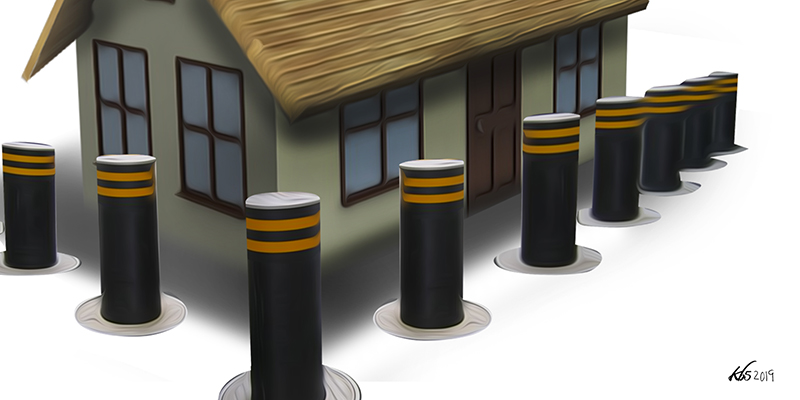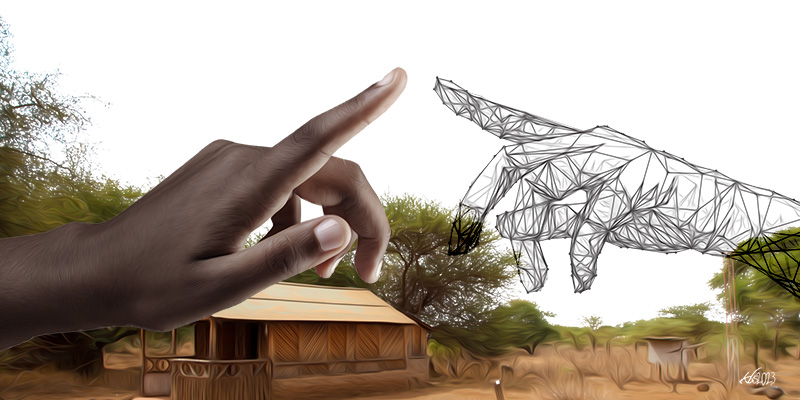It is nearly impossible to go a single day in Nairobi without going through “security.” It is a part of the urban landscape. Surveillance cameras, sniffer dogs, metal detectors, and concrete walls are all meant to deter terrorists and petty criminals; they communicate fortification, even in grocery stores and gyms.
But the visual language of security is full of paradoxes; while the quasi-militarised architecture seeks to reassure the public that we are safe from attack, it simultaneously acknowledges that we are indeed under attack, and all the time – only one unpredictable, unfortunate moment away from siege.
Another paradox: we endorse these forms of security through our daily acquiescence, but at the same time acknowledge its superficiality. Each time a bored or underpaid guard waves a metal detector wand around us –ignoring the beeping sound – and glances through our bags, we tell ourselves that this the whole exercise is pointless. Yet few complain or change their behaviour. And terrorist attacks continue to happen.
On 15 January, in 14 Riverside, which hosts the DusitD2 hotel and various commercial offices, a suicide bomber detonated himself at the Secret Garden Café. Other attackers forced their way through the single entrance using hand grenades and automatic weapons. Many victims were, tragically and fatefully, barricaded inside a “fortress.” While the vast majority of people trapped within the compound were rescued by private and state security forces, by the end of the siege, 21 people had been killed. Al Shabaab claimed responsibility for the attack.
George Musamali, a security analyst and CEO of the security firm Executive Protection Services, argues that the method of terrorist attacks evolves following the path of least resistance and that Kenya’s security apparatus has failed to keep up with the terrorists. Airplane hijackings, for example, were more common until heightened airport security made them more difficult. Then, car bombings like the twin attacks on the U.S. embassies in Nairobi and Dar es Salaam in 1998, became more common. Musamali says that after that restrictions on acquiring and transporting large quantities of explosives made this type to terrorist attack more difficult.
Now, of all the attacks in Kenya that have been claimed by Al Shabaab since 2011, the majority have involved active shooters. In the case of 14 Riverside, the same provisions that would have protected people from a bomb blast may have sealed victims in. Musamali says, “If you look at the modus operandi of Al Shabaab, they force their way in. More measures being recommended are not being implemented, so that’s why you find it so easy for Al Shabaab to use the same method in 2015 as in 2019. They see no change in tactics.”
The 14 Riverside attack has reinvigorated valid concerns about the security of commercial complexes in Nairobi, as key gaps in security at 14 Riverside are replicated in many other malls and compounds throughout the country. Perhaps the question we need to ask is what security really means for the public. Until then, we will continue to be sniffed, scanned, patted – and let through.
Guards, gadgets and now guns
Nairobi has always been a city obsessed with insecurity and, as a result, its residents are accustomed to security and surveillance. Because Nairobi did not truly ever break out of its original colonial, race-segregated lines, it got a head start on the privatisation of “public” space in the name of “securing” it. Mike Davis, writing about Los Angeles in the 1980s, pointed out that “the universal consequence of the crusade to secure the city is the destruction of any truly democratic urban space…. The ‘public’ spaces of the new megastructures and supermalls have supplanted traditional streets and disciplined their spontaneity.” He could just as well be describing Nairobi.
The 14 Riverside attack has reinvigorated valid concerns about the security of commercial complexes in Nairobi, as key gaps in security at 14 Riverside are replicated in many other malls and compounds throughout the country. Perhaps the question we need to ask is what security really means for the public. Until then, we will continue to be sniffed, scanned, patted – and let through.
A mosaic of fences and walls is designed to provide social insulation for upper class residents from the threat of the public poor. In this way, Nairobians have come to develop a peculiarly comfortable relationship with security apparatuses that would seem severe in other cities. Through perimeter walls, barbed wire, guards, and gates, Nairobi polices its social boundaries. “The fear of the criminal other has shaped Nairobi’s built form in profound ways,” writes anthropologist Constance Smith, “but has also led to a new architecture of desire and aspiration, influencing architectural aesthetics.” The security apparatus is not only an extension of fear, but also a marker of aspiration.
Because the public is so inured to life behind high walls and barbed wire (or outside of them) – in contrast with other cities where “the right to the street” is taken for granted – in Nairobi the extraordinary ubiquity of security is tolerated. It is more important that security is seen rather than guaranteed. Security consultant Andrew Franklin criticises what he calls the “industry of fear,” which is the market’s response to urban terrorism: “guards, gadgets, and now guns.” If this were not the case, perhaps there would be more investment in tactics that are less visible but equally effective.
For a mall, the bulk of the work in detecting and preventing a terror attack is painfully mundane. It is unglamorous, says Franklin, like examining food delivery boda bodas that move in and out of compounds, often unchecked. Or scanning deliveries that come in before dawn and get loaded in the morning. Franklin suggests that at least some of the ammunition used at the 14 Riverside attack was already within the compound – an insight echoed by other analysts with whom I spoke – indicating large gaps in security that have nothing to do with what people see when they enter and exit every day.
Because the public is so inured to life behind high walls and barbed wire (or outside of them) – in contrast with other cities where “the right to the street” is taken for granted – in Nairobi the extraordinary ubiquity of security is tolerated. It is more important that security is seen rather than guaranteed.
Another important but undervalued tool is counter-surveillance. Musamali recommends that malls, in addition to hiring trained observers to monitor suspicious activity, should also equip tenants with specialised observation skills. In London, for example, the city combatted terrorist attacks by the Irish Republican Army in part by training ordinary people to spot and flag behaviours that mark intention to plan a terror attack.
Locked city
Sometimes, in addition to being inconvenient, the architecture of security may actually compromise security. With its single entry point, the design of the 14 Riverside complex may have jeopardised the lives of those inside. One independent security analyst I spoke to (who chose to remain anonymous) said that there were originally meant to be twelve attackers at 14 Riverside. “Logistics made it difficult for the other to pursue. One group was supposed to actively engage in killing of hostages and the other six were supposed to engage the responders,” he said. “The other team did not arrive on time. [14 Riverside] only has one entrance. It could have been devastating.”
“We’re living in a concrete city where everyone has locked themselves in,” says Musamali. “If someone manages to break your access control, compromise it, and get in, then you definitely have given them easy targets because people do not have escape routes.”
The former analyst added that he knew the independent security company that previously completed a security assessment at 14 Riverside. Because the compound was originally intended to be only an office space, he said, there were additional recommendations the security company made to accommodate the presence of a hotel. Those suggestions were not heeded.
“We’re living in a concrete city where everyone has locked themselves in,” says Musamali. “If someone manages to break your access control, compromise it, and get in, then you definitely have given them easy targets because people do not have escape routes.”
Indeed, there is no legal obligation for building managements to achieve a certain standard of security, and those that do exist are seldom enforced. For example, the Occupational Safety and Health Act (2007) requires that all employers ensure that their employees are familiar with fire escape routes. Nevertheless, fire drills are few and far between. In the case of 14 Riverside, not all who were trapped within the building knew of or were able to access the small pedestrian walkway in the rear.
Furthermore, and equally disturbing, there are scant standards or guidelines for private security companies in Nairobi. Byron Adera, a pioneer Kenya Special Forces officer and security consultant, says that mediocrity runs throughout the sector: “You see different uniforms, different malls, but it’s the same kind of searching that is done. They’ve got a wand in their hands, and they sweep you without asking questions if it beeps.”
To fill the void in industry standards, Adera and other former military personnel have formed the Association of Corporate and Industrial Security Management Professionals, an organisation that liaises with the government, security providers, building managements, and other stakeholders to develop and enforce standards for security providers.
But, even if there are standards of quality for security provision, there is no obligation for mall managements to invest in it—and, perhaps worryingly, little financial incentive to do so. Previously, the (anonymous) analyst had been approached by the management of a well-known mall in Westlands to run a security audit, but, after quoting the cost of his services, the management decided not to move forward, citing cost. “The management of these properties only look at the bottom line,” he said. “They don’t look at other factors.”
In other countries, it is understood that the intention of terrorists is to make crowded spaces “empty” – to terrorise the public into retreating inwards in fear. But in Nairobi, where inclusive, truly public spaces have long been “designed” out, where the attack happened in one of the most insulated, formidable-looking, closed-off, “safest” places, the horror of urban terror attacks runs deeper.
On 4 February 2019, the U.S. Embassy issued a warning to its citizens to avoid areas frequented by tourists and foreigners, as there was risk of another terror attack. The risk will not wane. For the first time, for the city’s walled-off elites, there are no “safe zones” left. Not only are the trappings of security to which we comply daily ineffective but they are perhaps the very thing which makes us targets.








